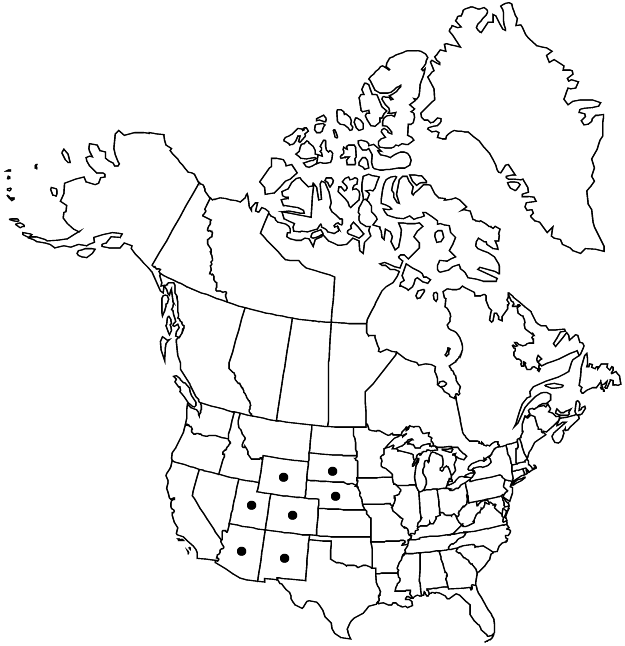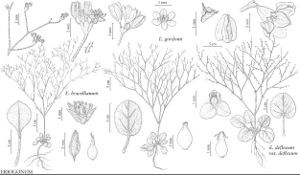Difference between revisions of "Eriogonum gordonii"
in A. P. de Candolle and A. L. P. P. de Candolle, Prodr. 14: 20. 1856.
FNA>Volume Importer |
imported>Volume Importer |
||
| (One intermediate revision by one other user not shown) | |||
| Line 1: | Line 1: | ||
{{Treatment/ID | {{Treatment/ID | ||
|accepted_name=Eriogonum gordonii | |accepted_name=Eriogonum gordonii | ||
| − | |accepted_authority=Bentham | + | |accepted_authority=Bentham |
|publications={{Treatment/Publication | |publications={{Treatment/Publication | ||
|title=in A. P. de Candolle and A. L. P. P. de Candolle, Prodr. | |title=in A. P. de Candolle and A. L. P. P. de Candolle, Prodr. | ||
| Line 8: | Line 8: | ||
}} | }} | ||
|common_names=Gordon’s wild buckwheat | |common_names=Gordon’s wild buckwheat | ||
| + | |special_status={{Treatment/ID/Special_status | ||
| + | |code=F | ||
| + | |label=Illustrated | ||
| + | }}{{Treatment/ID/Special_status | ||
| + | |code=E | ||
| + | |label=Endemic | ||
| + | }} | ||
|basionyms= | |basionyms= | ||
|synonyms= | |synonyms= | ||
| Line 33: | Line 40: | ||
-->{{#Taxon: | -->{{#Taxon: | ||
name=Eriogonum gordonii | name=Eriogonum gordonii | ||
| − | |authority=Bentham | + | |authority=Bentham |
|rank=species | |rank=species | ||
|parent rank=subgenus | |parent rank=subgenus | ||
| Line 46: | Line 53: | ||
|publication title=in A. P. de Candolle and A. L. P. P. de Candolle, Prodr. | |publication title=in A. P. de Candolle and A. L. P. P. de Candolle, Prodr. | ||
|publication year=1856 | |publication year=1856 | ||
| − | |special status= | + | |special status=Illustrated;Endemic |
| − | |source xml=https:// | + | |source xml=https://bitbucket.org/aafc-mbb/fna-data-curation/src/2e0870ddd59836b60bcf96646a41e87ea5a5943a/coarse_grained_fna_xml/V5/V5_801.xml |
|subfamily=Polygonaceae subfam. Eriogonoideae | |subfamily=Polygonaceae subfam. Eriogonoideae | ||
|genus=Eriogonum | |genus=Eriogonum | ||
Latest revision as of 22:14, 5 November 2020
Herbs, erect to spreading, annual, (0.5–)1–5(–7) dm, glabrous or sparsely hispid, grayish. Stems: caudex absent; aerial flowering stems erect, solid, not fistulose, 0.5–1.5(–3) dm, glabrous or sparsely hispid. Leaves basal; petiole 1–5 cm, glabrous or sparsely hirsute; blade obovate to round or reniform, 1–5 × 1–5 cm, sparsely villous to hirsute and green on both surfaces, becoming glabrous with age, margins plane. Inflorescences cymose, open to dense, 5–40(–50) × 5–50 cm; branches not fistulose, glabrous or sparsely hispid; bracts 3, scalelike, 0.5–2(–3) × 0.5–2.5 mm. Peduncles erect, straight, slender, 0.5–2.5(–4) cm, glabrous. Involucres campanulate, 0.6–1.5 × 0.8–1.5 mm, glabrous; teeth 5, erect, 0.2–0.4 mm. Flowers 1–2.5 mm; perianth white with greenish or reddish midribs, rarely yellowish, becoming pink to rose, glabrous; tepals monomorphic, oblong to narrowly ovate; stamens included to exserted, 1–1.8 mm; filaments glabrous. Achenes shiny light brown to brown, 3-gonous, 2–2.5 mm, glabrous.
Phenology: Flowering May–Oct.
Habitat: Sandy to clayey flats and slopes, saltbush, greasewood, and sagebrush communities, pinyon and/or juniper or montane conifer woodlands
Elevation: 900-2200 m
Distribution

Ariz., Colo., Nebr., N.Mex., S.Dak., Utah, Wyo.
Discussion
Eriogonum gordonii is common to even locally abundant throughout a range that extends in an arc from the Colorado Plateau of extreme northern Coconino and Apache counties, Arizona, and San Juan County, New Mexico, northward through the desert regions of eastern Utah and western Colorado into southwestern Wyoming, then northeastward mainly in short-grass prairie through east-central Wyoming and extreme northwestern Nebraska to South Dakota. A series of disjunct populations occurs in Fremont and Las Animas counties in Colorado. The species can be weedy in appearance but usually is absent from areas of significant disturbance, unlike other annual wild buckwheats.
Selected References
None.
